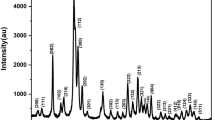Abstract
HAp powder with crystallite and particle sizes in the nanorange was prepared by a solution combustion method using glycine as fuel. The powders were characterized for phase and functional group, crystallite size, particle size and agglomerate size, morphology, surface area and sericin protein adhesion. The powder had a crystallite size in the range of 10–20 nm, a particle size in the range of 100–200 nm and a surface area of 10–16 m2/g. The nanosized HAp powder was mixed with de-ionized water to prepare a slurry with solid loading in the range of 20–40 vol.-%, which was homogenized by ball milling for 16–20 h and then cast in to plaster moulds. The slip cast samples sintered at 1250°C for 1 h were found ta have a bulk density in the range of 50–78%, an apparent porosity of 13–43% and a micropore size in the range of 0.5–5.0 µm. The three-point flexural strength and compressive strength values were correlated to the porosity of sintered HAp samples.
Similar content being viewed by others
References
Hench, L.L.: Bioceramics from concept to clinic. J. Am. Ceram. Soc. 74 (1991) [7] 1487–1510
Lobo, S.E., Arinzeh, T.L.: Biphasic calcium phosphate ceramics for bone regeneration and tissue engineering applications. Open access Materials 3 (2010) [2] 815–826
Bignon, A., Choreteau, J., Chevalier, J., Fantozi, G., Carret, J.-P., Chavassieux, P. et al.: Effect of micro and macro porosity of bone substitutes on their mechanical properties and cellular response. J. Mater. Sci. Mater. Med. 14 (2003) [12] 1089–97
Hing, K.A., Annaz, B., Saeed, S., Revell, P.A., Buckland, T.: Microporosity enhances bioactivity of synthetic bone graft substitutes. J. Mater. Sci. Mater. Med. 16 (2005) [5] 467–75
Woodard, J.R., Hilldore, A.J., Lan, S.K., Park, C.J., Morgan, A.W., Eurell J.A.C. et. al.: The mechanical properties and osteoconductivity of hydroxyapatite bone scaffolds with multi scale porosity. Biomaterials 28 (2007) 45–54
Christenson, E.M., Anseth, K.S., van den Beucken, J.J.J.P., Chan, C.K., Ercan, B., Jansen, J.A., Laurencin, C.T., Wan-Ju Li, Murugan, R., Nair, L.S., Ramakrishna, S., Tuan, R.S., Webster, T.J., Mikos, A.G.: Nanobiomaterial applications in orthopedics. J. Orthopaedic Res. 25 (2007) [1] 11–22
Ramachandra Rao, R., Roopa, H.N., Kannan, T.S.: Solid state synthesis and thermal stability of HAp and HAp-β-TCP composite ceramic powder. J. Mater. Sci. Mater. Med. 8 (1997) [8] 511–518
Nayak, A.K.: Hydroxyapatite synthesis methodologies: An overview. Int. J. Chem. Tech. Res. 2 (2010) [2] 903–907
Ferraz, M.P., Monteiro F.J., Manuel, C.M.: Hydroxyapatite nanoparticles: A review of preparation methodologies. J. Appl. Biomater. and Biomech. 2 (2004) 74–80
Cuneyt Tas, A.: Combustion synthesis of calcium phosphate bioceramic powders. J. Eur. Ceram. Soc. 20 (2000) [14–15] 2389–2394
Han, Y., Li, S., Wang, X., Chen, X.: Synthesis and sintering of nanocrystalline hydroxyapatite powders by citric acid sol-gel combustion method. Mater. Res. Bull. 39 (2004) [1] 25–32
Pratihar, S.K., Garg, M., Mehra, S., Bhattacharya, S.: Phase evolution and sintering kinetics of hydroxyapatite synthesized by solution combustion technique. J. Mater. Sci. Mater. Med. 17 (2006) [6] 501–507
Sasikumar, S., Vijayaraghavan, R.: Synthesis and characterization of bioceramic calcium phosphates by rapid combustion synthesis. J. Mater. Sci. Technol. 26 (2010) [12] 114–118
Ghosh, S.K., Roy, S.K., Kundu, B., Datta, S., Basu, D.: Synthesis of nano-sized hydroxyapatite powders through solution combustion route under different reaction conditions. Mater. Sci. and Eng. B, 176 (2011) [1] 14–21
Ramachandra Rao R., Kannan, T.S.: Dispersion and slip casting of hydroxyapatite. J. Am. Ceram. Soc. 84 (2001) [8] 1710–1716
Ramachandra Rao, R., Mariappan L., Roopa, H.N.: Fabrication of micro-featured shapes of alumina ceramics. Procedia Mater. Sci. 5 (2014) 2595–2604
Began, H., Chanda, A., Kundu, B.: Development of nano-grained calcium hydroxyapatite using slip casting technique. Int. J. Scientific and Eng. Res. 21 (2001) [3] 1–7
Sepulveda, P., Ortega, F.S., Innocentini M.D.M., Pandolfelli, V.C.: Properties of highly porous hydroxyapatite obtained by the gel casting of foams. J. Am. Ceram. Soc. 83 (2000) [12] 3021–3024
Lee, E., Koh, Y., Yoon, B., Kim, H., Kim, H.: Highly porous hydroxyapatite bioceramics with interconnected pore channels using camphene-based freeze casting. Mater. Letters 61 (2007) 2270–2273
Arita, I.H., Wilkinson D.S., Castazo, V.M.: Synthesis and processing of hydroxyapatite ceramic tapes with controlled porosity. J. Mater. Sci. Mater. Med. 6 (1995) [1] 19–23
Bose, S., Vahabzadeh, S., Bandyopadhyay, A.: Bone tissue engineering using 3D printing. Materials today 16 (2013) [12] 496–504
Hutmacher, D.W., Sittinger M., Risbud, M.V.: Scaffold-based tissue engineering: Rationale for computer-aided design and solid free-form fabrication systems. Trends in Biotechnology 22 (2004) [7] 354–362
Ramachandra Rao, R.: Current Trends in Processing and Shaping of Bioceramics. E-Book Chapter in: Current Trends on Glass and Ceramic Materials, Eds. Sooraj Hussain, N., da Silva Santos, J.D., University of Porto, Portugal, Bentham Science Publishers, The Netherlands (2013) 3–48, ISBN: 978-1-60805-514-2, eISBN: 978-1-60805-452-7
Thangamani, N., Chinnakali K., Gnanam, F.D.: The effect of powder processing on densification, microstructure and mechanical properties of hydroxyapatite. Ceram. Inter. 28 (2002) [4] 355–362
Tian, T., Jiang, D., Zhang J., Lin, Q.: Aqueous tape casting process for hydroxyapatite. J. Eur. Ceram. Soc. 27 (2007) 2671–2677.
Padilla, S., Vallet-Regí, M., Ginebra M.P., Gil, F.J.: Processing and mechanical properties of hydroxyapatite pieces obtained by the gelcasting method. J. Eur. Ceram. Soc. 25 (2005) 375–383
Kikuchi, M.: Effect of test circumstances on compressive strength of porous calcium phosphate ceramics for establishment of standard measurement condition. Bioceramics Develop. and Appl. 1 (2011) 1–3, doi: 10.4303/bda/D101201
Author information
Authors and Affiliations
Corresponding author
Rights and permissions
About this article
Cite this article
Rao, R.R., Roopa, H.N. & Mariappan, L. Development of Microporous Scaffolds through Slip Casting of Solution Combustion Derived Nano Hydroxyapatite. Interceram. - Int. Ceram. Rev. 65, 100–105 (2016). https://doi.org/10.1007/BF03401159
Received:
Published:
Issue Date:
DOI: https://doi.org/10.1007/BF03401159




